|
|
Senusret I Obelisk (Faiyum)
| Present Site: | Faiyum, Egypt At the intersection of Nabwy Street and Nasir Street N 29°18'55.0"(29.315287) E 30°51'09.0"(30.852491) |
| Pharaoh: | Senusret I (Middle Kingdom the 12th Dynasty, Reigned 20 Century BC) |
| Measurement: | About 13 meters high for obelisk itself |
| Stone: | Red granite |
About The Site:
Faiyum is a modern city in Middle Egypt, located about 100 km southwest of Cairo, with a population of 350,000.
It's often called as a town in Faiyum Oasis, but it's not an image of
The obelisk stands at the intersection of two broad streets; Nabwy Street (El-Nabwy) and Nasir Street (Gamal Abd El-Nasir) in Faiyum (see map right). It's far about 800-meter northeast from the city center of Modern Faiyum. When erecting this obelisk in 1970s, the intersection of the main streets which were newly made in the new town at that time was chosen as the place, I assume.
Since my trip to Faiyum was a very short stay, I missed many points of interest, such as vast Lake Qarun, Pyramid in Middle Kingdom (Lahun Pyramids), and many historic water wheels. Most people won't visit Faiyum to see the Obelisk alone. For visiting Faiyum, the website Explore Fayoum would be useful.
How To Get There:
The train for Faiyum would be inconvenient because it's 4 times a day, and takes 4 hours one way. The long-distance bus is also available, but I didn't use it as the travel time was uncertain. So, I hired a taxi at Cairo. It costed 400 EGP (about USD 60) for 5 hours, as it was an air-conditioned decent car.
The road from Cairo to Faiyum via Giza is well-maintained, but it may be crowded until Giza. Also, there was a checkpoint on the way and it was a little congested. It would take about 2 hours one way.
It's easy to get there as the obelisk stands at the center of roundabout at the heavy traffic intersection. If you tell the names of two main streets; Nabwy Street (El-Nabwy) and Nasir Street (Gamal Abd El-Nasir) and/or show a picture of obelisk to the taxi driver, he will easily guide you to the destination.
About The Obelisk:
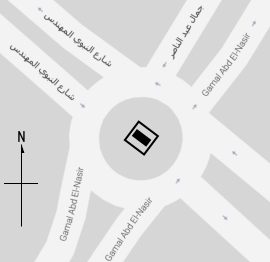
| |
|
Brief Ichnography:
Northwest side & Southeast side are Longer |
 This is an obelisk of Senusret I (Reigned 1971-1926 BC), which is about 13 meters high. Sometime, books and websites don't refer to this obelisk, because this is sometime recognized as a stone monument (or stela), not an obelisk. For example, Wallis Budge, who has been responsible to the British Museum for many years, says in his book "Cleopatra's Needles and Other Egyptian Obelisks" (1926), "It is a colossal stele rather than an obelisk, for it is nearly 7 feet wide and is about 4 feet thick; but it is usually called the "obelisk of Begig." Thus, he is in a delicate position, although he referres to this in the book on the obelisk.
This is an obelisk of Senusret I (Reigned 1971-1926 BC), which is about 13 meters high. Sometime, books and websites don't refer to this obelisk, because this is sometime recognized as a stone monument (or stela), not an obelisk. For example, Wallis Budge, who has been responsible to the British Museum for many years, says in his book "Cleopatra's Needles and Other Egyptian Obelisks" (1926), "It is a colossal stele rather than an obelisk, for it is nearly 7 feet wide and is about 4 feet thick; but it is usually called the "obelisk of Begig." Thus, he is in a delicate position, although he referres to this in the book on the obelisk.I didn't notice the inscription of this obelisk at all when I was taking pictures, although Wallis Budge refers to the inscription (fragment) in his book. The surface of this obelisk was the fairly flat stone pillar in fact, with the same hights of the obelisks of Esquilino and Quirinale. Furthermore, the top shape of this obelisk was rounded, instead of a pyramidion shape, I was taking pictures of four sides while feeling "it would be reasonable that it's not considered as an obelisk."
I did realize the faint rectangular frame of the inscription on northeast side and the illustration like a horus at top, after returning to my home, when I was reviewing my pictures. The stone material used when repaired and the original stone material differ slightly in color, so we can imagine how it was repaired. However, I couldn't confirm other hieroglyphs at all in my pictures. What I was surprised that the rectangular frame surrounding the inscription did not match the center line of the restored obelisk, and it was tilted about 1 degree. The left picture indicates the portion in yellow which the rectangular frame line remains.
After I realized this, I did review the picture more carefully, and I noticed that the inscription on southwest side remains most. I barely can read the horsul name of Senusret I under the horus weared the double crown, and the coronation name as well.
I also learned the reason why the top shape of this obelisk is rounded while I was reading the literatures. That would be a result that the people tried to do the best effort to restore to the original state when re-erection, even though the stone material was largely broken.
Notes For Pictures:
Since the obelisk is standing at the center of roundabout, and the cars were constantly running, but fortunately there was an enough circular space around the obelisk, so I could take pictures from there, not going out to the drive way. However, the obelisk was in a miserable state with graffiti and many posters, as there was no fence around the obelisk. (See pictures below)
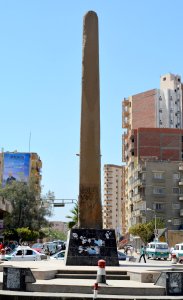
Northeast side |
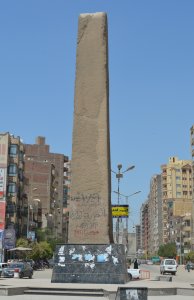 Southeast side |
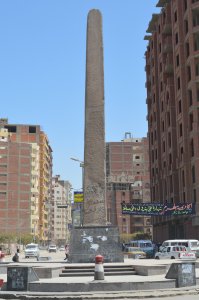 Southwest side |
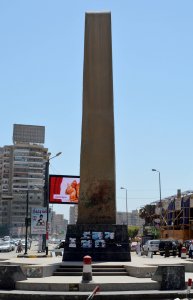 Northwest side |
|||
August 6, 2014 by Hiroyuki Nagase (For high definition image, please click the picture)
| ||||||
Copyright Hiroyuki Nagase nagase@obelisks.org and Shoji Okamoto okamoto@obelisks.org